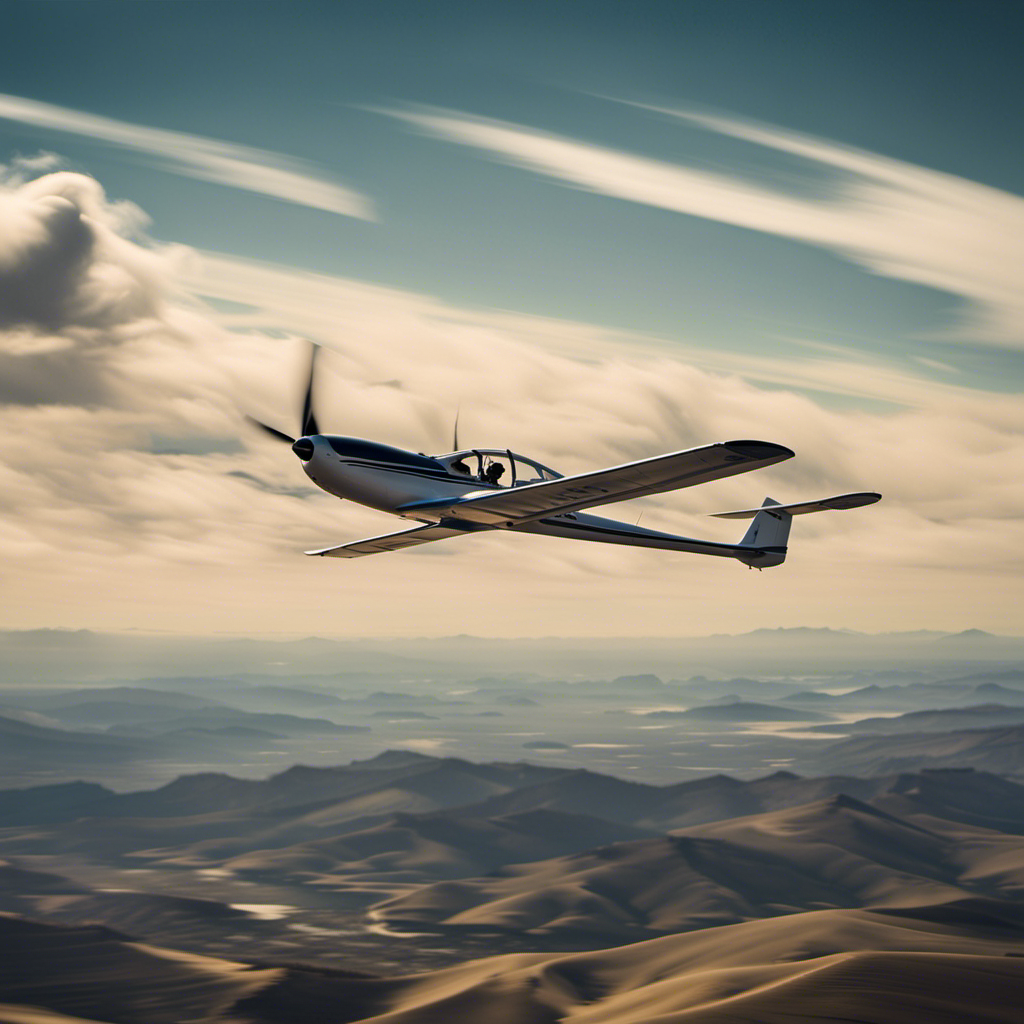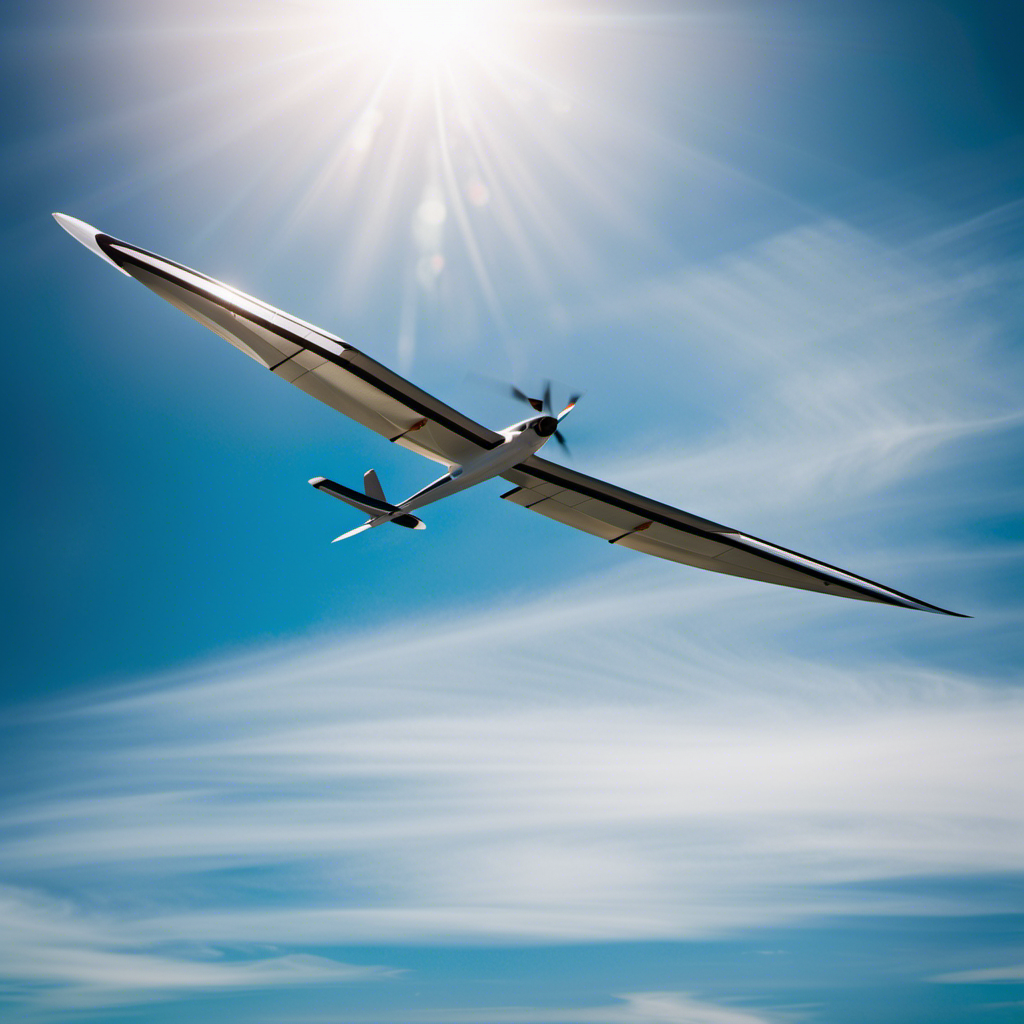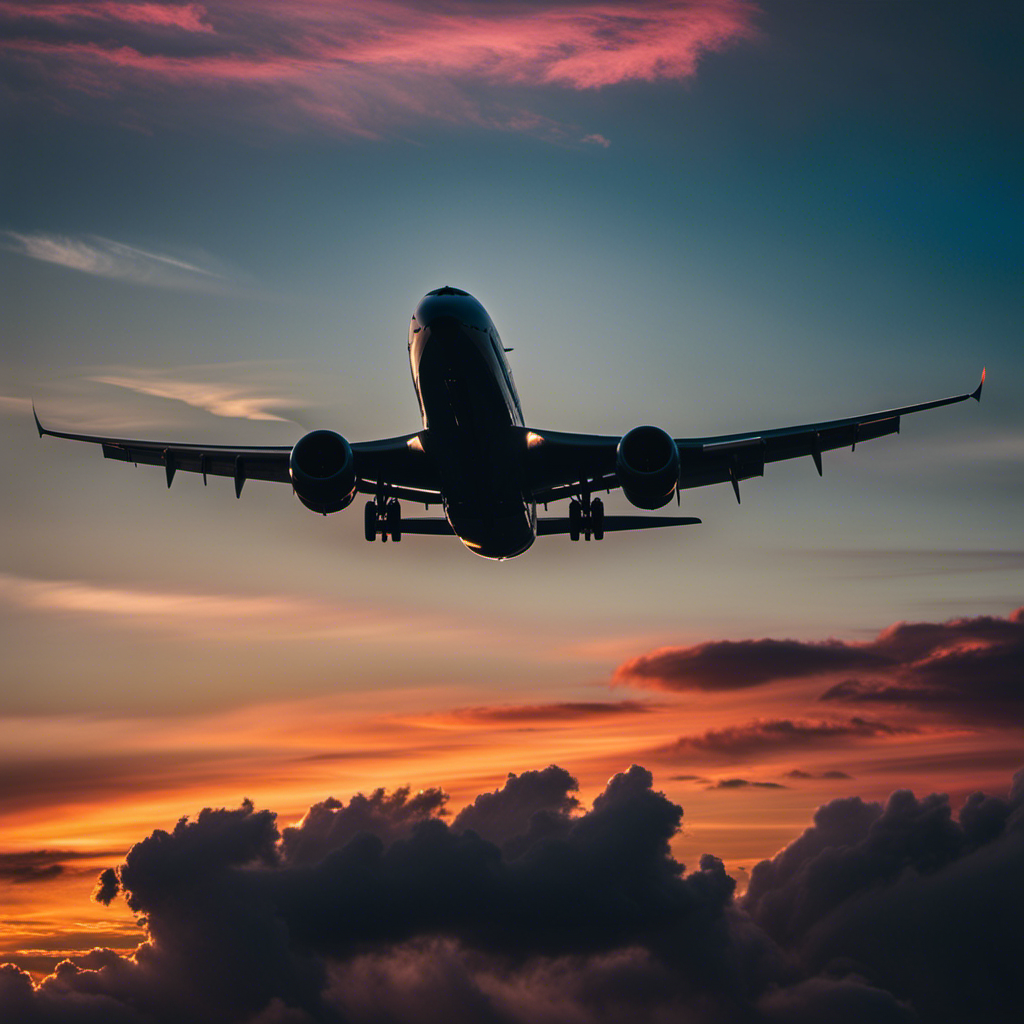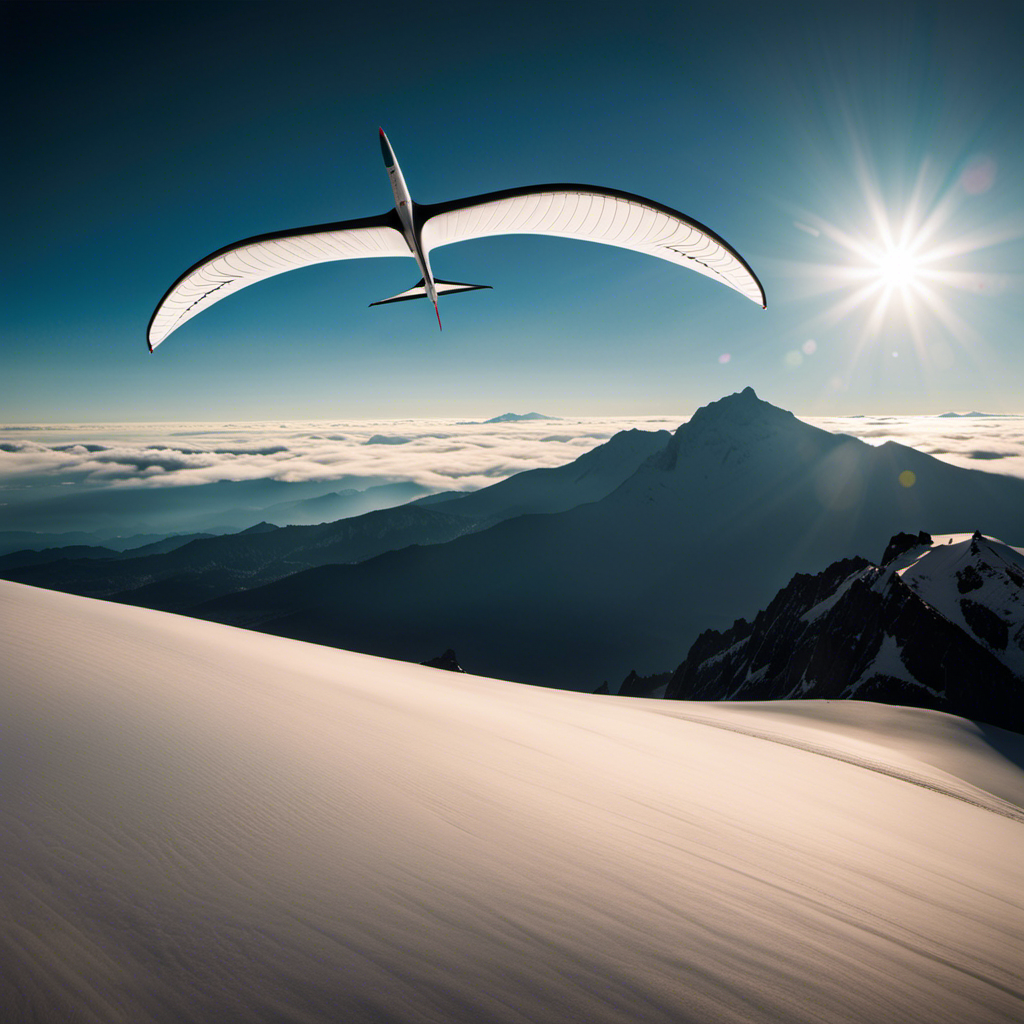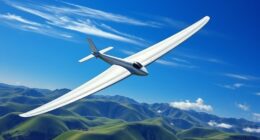As a glider pilot, I can confirm that gliding is like dancing in harmony with the wind. It is an elegant and thrilling activity that uses the power of nature to soar through the skies.
In this article, we will explore the mechanics behind gliding, the various types of gliders, and the techniques used to control and maneuver these aircraft.
So fasten your seatbelt and get ready to embark on a thrilling journey into the world of gliding.
Key Takeaways
- Gliding is possible due to the forces of lift and gravity, with lift being generated by the shape of the wing and the flow of air over and under it.
- Gliders are designed to maximize lift and minimize drag, with aerodynamic principles being essential for efficient flights.
- There are various types of gliders tailored to specific needs and conditions, with different launching techniques such as winch launch, tow launch, and foot launch.
- Controlling the glider is achieved through the use of ailerons, elevators, and rudder, which work together to control roll, pitch, and yaw respectively.
The Forces of Gliding
Gliding is possible due to the forces of lift and gravity. To understand lift, we must first grasp the concept of an airfoil. An airfoil is a shape that, when moving through the air, generates lift. It is designed to take advantage of Bernoulli’s principle, which states that as the speed of a fluid (in this case, air) increases, its pressure decreases.
Gliding equipment, such as gliders or sailplanes, are specifically designed to maximize lift and minimize drag. They have sleek, aerodynamic shapes and long wingspans to provide enough lift to keep the glider airborne.
In addition to lift, gravity also plays a crucial role in gliding. It provides the necessary force to descend and maintain a controlled descent.
Transitioning into the next section, let’s explore the different types of gliders and their unique characteristics.
Different Types of Gliders
There are various types of gliders that are used for different purposes. Gliders come in a wide range of designs, each tailored to specific needs and conditions.
Some gliders are designed for high-performance soaring, with sleek and aerodynamic shapes that minimize drag and maximize lift. Others are built for more recreational purposes, providing stability and ease of control.
Regardless of the design, regular maintenance is crucial to ensure the safety and performance of a glider. This includes regular inspections, cleaning, and repair of any damage. Additionally, proper storage and transportation practices are essential to protect the glider from environmental elements and potential damage.
Understanding the aerodynamics of gliding is the next step in comprehending how gliders are able to fly without an engine.
Understanding Aerodynamics
To understand aerodynamics, you need to grasp the concept of lift and how it is generated. Aerodynamic principles play a crucial role in gliding physics. Lift is the force that enables a glider to stay airborne and counteracts the force of gravity. It is generated by the shape of the wing and the flow of air over and under it. The wing’s curved upper surface and flatter lower surface create a pressure difference, resulting in lift. This can be further explained using Bernoulli’s principle, which states that as the speed of a fluid increases, its pressure decreases. The table below illustrates the relationship between airspeed, pressure, and lift.
| Airspeed (mph) | Pressure (psi) | Lift (lbs) |
|---|---|---|
| 30 | 14 | 250 |
| 40 | 12 | 350 |
| 50 | 10 | 450 |
| 60 | 8 | 550 |
| 70 | 6 | 650 |
Understanding these aerodynamic principles is essential for glider pilots to maximize their lift and achieve longer and more efficient flights. Now let’s explore the various launching techniques used in gliding, which allow pilots to get their gliders airborne without the use of an engine.
Launching Techniques
When it comes to launching techniques in gliding, there are three main methods that pilots use: winch launch, tow launch, and foot launch.
A winch launch involves a cable attached to the glider, which is then pulled by a winch to gain altitude.
In a tow launch, the glider is towed behind a powered aircraft until it reaches the desired height.
Finally, a foot launch is when the pilot runs off a hill or cliff, using the natural lift or updrafts to gain altitude.
Each method has its own advantages and considerations, and understanding these techniques is crucial for a successful gliding experience.
Winch Launch
You can experience the thrill of a winch launch by being pulled into the air by a cable attached to a powerful winch. Winch launches are an important and widely used method in gliding.
Safety is of utmost importance during a winch launch. Before the launch, the cable tension, hooking and release mechanism, and the winch itself are thoroughly inspected. The winch operator is highly trained to ensure smooth and controlled launches.
As the glider is connected to the cable, it is essential to maintain proper alignment and balance to prevent any accidents. Once everything is in place, the winch is engaged, and the glider is rapidly pulled into the air.
The technique involves maintaining a steady climb rate and controlling the glider’s attitude using the control surfaces. With a successful winch launch, the glider gains enough altitude to transition into a tow launch, where it can continue its flight with the assistance of a towplane.
Tow Launch
Make sure your glider is properly connected to the towplane before engaging the winch for a tow launch. This is crucial for a safe and successful flight.
Once connected, I activate the winch to gradually increase tension on the towline. As the towplane accelerates, I maintain constant communication with the pilot, ensuring a smooth takeoff.
Once airborne, I focus on maintaining proper altitude control by adjusting the elevator and trim settings. The tow release is a critical component that allows me to disconnect from the towplane when I reach my desired altitude. It is important to perform this maneuver smoothly to avoid any sudden jolts or loss of control.
Now, let’s move on to the next phase of gliding: the foot launch.
Foot Launch
The foot launch requires a strong push to gain enough speed for takeoff. This technique involves running with the glider attached to my body, and then using my legs to generate the necessary momentum. It is crucial to maintain proper balance and coordination during the launch.
Before attempting the foot launch, it is important to ensure that the glider is in optimal condition. Regular glider maintenance is necessary to keep all components functioning properly and to prevent any potential issues during flight. This includes inspecting the wing, checking the lines, and ensuring that the harness is secure.
By following these foot launch techniques and properly maintaining the glider, I can ensure a safe and successful takeoff.
Now, let’s move on to controlling the glider without skipping a beat.
Controlling the Glider
When it comes to controlling a glider, three key components play a crucial role: the ailerons, elevators, and rudder.
Ailerons are located on the wings and are responsible for controlling the roll of the glider, allowing it to bank left or right.
Elevators, on the other hand, are found on the tail and control the pitch, enabling the glider to climb or descend.
Lastly, the rudder, also on the tail, is responsible for controlling the yaw, allowing the glider to turn left or right.
These three control surfaces work together to give the pilot precise control over the glider’s movements in the air.
Ailerons
To control the roll of the aircraft while gliding, pilots use ailerons. Ailerons are control surfaces located on the wings of the glider. They work by moving in opposite directions: when one aileron goes up, the other goes down. This creates a difference in lift between the wings, causing the glider to roll. By manipulating the ailerons, pilots can control the bank angle of the glider during turns.
Here are some gliding techniques that involve the use of ailerons:
- Coordinated turns: Using ailerons together with rudder to maintain balance and prevent yawing.
- Slip: Using ailerons to decrease lift on one wing, allowing the glider to descend rapidly.
- Skid: Using ailerons to increase lift on one wing, creating a sideways motion.
By mastering these techniques, pilots can effectively control their gliders during various flight situations.
Now let’s move on to the next control surface: elevators.
Elevators
After discussing the crucial role of ailerons in controlling the roll of a glider, let’s now move on to another vital control surface: elevators.
Elevators are found on the tail of the glider and are responsible for controlling the pitch, or the up and down movement of the aircraft. By adjusting the elevators, a pilot can change the angle of attack, allowing the glider to climb or descend.
During gliding competitions, skilled pilots utilize elevators to optimize their flight performance. They carefully adjust the elevators to maintain the desired glide ratio and achieve maximum efficiency. By constantly monitoring and fine-tuning the elevator settings, pilots can exploit rising air currents and stay aloft for longer periods, increasing their chances of winning.
Now, let’s transition into the subsequent section about the rudder, which plays a crucial role in controlling the yaw of a glider.
Rudder
The rudder is located on the tail of the glider and is responsible for controlling the yaw, or the left and right movement of the aircraft. By manipulating the rudder control, I can maintain glider stability during flight.
Here are five key aspects of rudder control in gliding:
- The rudder is a movable surface that can be deflected to the left or right.
- It works in conjunction with the elevator to ensure proper control of the glider.
- The pilot uses their feet on the rudder pedals to control the movement.
- Deflecting the rudder to one side creates a differential drag, causing the glider to yaw in that direction.
- The rudder is crucial for coordinated turns, preventing adverse yaw that can lead to instability.
Now, let’s move on to the next step, which involves finding thermals without compromising the glider’s stability.
Finding Thermals
As a glider pilot, understanding thermals is crucial to gaining altitude and extending flight time.
Thermals are pockets of rising air caused by the sun heating the ground, which in turn heats the air above it.
Identifying thermals involves paying close attention to visual cues such as cumulus clouds, dust devils, and birds circling in a specific area.
Once identified, utilizing thermals effectively can allow a pilot to soar and climb to higher altitudes, maximizing the potential for a successful and prolonged gliding experience.
What are Thermals?
To find thermals while gliding, you’ll need to look for rising air currents. Thermals are columns of warm air that rise from the ground due to heating from the sun.
As a glider pilot, understanding thermals is crucial for maximizing glider performance and staying aloft for extended periods. When a glider enters a thermal, it gains altitude as it is lifted by the upward-moving air. This allows the pilot to extend their flight and cover greater distances.
Thermals can vary in strength and size, and their presence can be indicated by visually observing the behavior of birds, cloud formations, or even by using instruments such as variometers.
Identifying thermals is essential for successful gliding and ensuring a safe and efficient flight.
How to Identify Thermals
After learning about thermals and their formation, it is crucial to understand how to identify them during gliding. The ability to spot thermals is essential for maximizing altitude gain and prolonging your flight.
One method to identify thermals is to look for visual cues such as cumulus clouds or birds soaring in circles. These indicators suggest the presence of rising air currents.
Additionally, observing the terrain can help in identifying thermals. Areas with dark patches of ground, such as plowed fields or asphalt roads, tend to absorb more heat and generate thermals.
Analyzing wind direction and speed can also provide valuable insights. A sudden change in wind direction or an increase in wind speed may indicate the presence of a thermal.
By honing your skills in thermals identification, you can effectively utilize these rising air currents to gain altitude and extend your gliding experience.
Transitioning into the subsequent section, let’s explore the techniques for using thermals to gain altitude.
Using Thermals to Gain Altitude
One effective way to gain altitude during gliding is by utilizing thermals. Thermals are columns of rising air that can be found by looking for certain indicators in the sky. Here are three key steps to finding and using thermals to gain altitude:
-
Look for cumulus clouds: Cumulus clouds are a good indication of thermals because they are formed by the rising warm air. Pay attention to the size and shape of the clouds, as larger and more defined cumulus clouds often indicate stronger thermals.
-
Observe bird behavior: Birds are experts at finding thermals, so keep an eye out for their flight patterns. If you see birds circling in one area, it is likely that they have found a thermal. Follow their lead to gain altitude.
-
Feel for changes in air temperature: As you glide, pay attention to any sudden changes in air temperature. Warmer air indicates the presence of a thermal. Use this information to adjust your flight path and enter the thermal.
By effectively using thermals, gliders can gain altitude and extend their flight time.
Transitioning into the next section about gliding techniques, it is important to note that utilizing thermals is just one aspect of mastering the art of gliding.
Gliding Techniques
There are various techniques for gliding that experienced pilots use. These techniques are designed to maximize their efficiency and safety while in the air. Here are three commonly used gliding techniques:
| Technique | Description | Purpose |
|---|---|---|
| Straight Gliding | Flying in a straight line without any turns or maneuvers | Maintains a constant speed and direction |
| Slope Soaring | Utilizing wind hitting a slope to generate lift | Allows the glider to gain altitude without using thermals |
| Dynamic Soaring | Flying in a circular path to utilize wind shear | Increases the glider’s speed and provides additional lift |
These gliding techniques require careful consideration of safety measures. Pilots must always be aware of their surroundings, weather conditions, and potential obstacles. Additionally, proper training and adherence to gliding regulations are essential for safe and successful flights. Transitioning into the next section on safety considerations, it is crucial to understand how these techniques can impact the overall safety of gliding.
Safety Considerations
After mastering the various gliding techniques, it is crucial to consider the safety aspects of this exhilarating activity. Safety procedures and emergency protocols are essential to ensure a smooth and secure gliding experience.
Before taking off, it is crucial to perform a thorough pre-flight inspection of the glider, checking for any signs of damage or malfunctions. During the flight, maintaining proper communication with the ground crew and other pilots is vital for safety. Additionally, understanding weather patterns and being aware of potential hazards such as strong winds or thunderstorms is essential.
In the event of an emergency, pilots must be well-versed in emergency protocols, including procedures for dealing with equipment failures or unexpected weather changes. By adhering to these safety considerations, gliders can enjoy the thrill of soaring through the skies with confidence and peace of mind.
Transitioning into the subsequent section about gliding competitions, let’s now delve into the competitive side of this remarkable sport.
Gliding Competitions
To fully immerse yourself in the world of gliding competitions, you must first understand the different types of events and the skills required for each one. Gliding competitions are thrilling and demanding, testing pilots’ abilities in various ways.
Here are three key aspects of gliding competitions that will surely pique your interest:
-
Cross-Country Racing: This event challenges pilots to navigate through a pre-determined course, using gliding techniques such as thermalling and ridge soaring to maximize their distance and speed.
-
Aerobatics: In this event, pilots showcase their precision and control by performing a series of maneuvers and figures, including loops, rolls, spins, and inverted flight.
-
Distance Racing: Pilots in this event aim to cover the longest distance possible within a specific time frame, utilizing gliding techniques and strategic planning to optimize their flight path.
Gliding competitions require not only exceptional flying skills but also strict adherence to safety precautions. These include thorough pre-flight inspections, proper use of safety equipment, and maintaining situational awareness throughout the competition.
With an understanding of these events and safety measures, you can now explore the myriad gliding resources and organizations available to support your gliding journey.
Gliding Resources and Organizations
Gliding resources and organizations offer a wealth of information and support for aspiring pilots. They provide crucial information about upcoming competitions, including details about the location, rules, and registration process.
Gliding clubs, often affiliated with these organizations, offer a community of like-minded individuals who share a passion for gliding. They provide opportunities for pilots to connect, learn from experienced gliders, and participate in group flights. These clubs also organize training programs and workshops to help pilots improve their skills and knowledge.
In addition, gliding resources and organizations publish educational materials, such as manuals and guides, which cover a wide range of topics related to gliding techniques, safety procedures, and maintenance tips.
Overall, these resources and organizations play a vital role in the gliding community, fostering growth, and providing support for both aspiring and experienced pilots.
Frequently Asked Questions
Are there any specific weight requirements for gliding?
Weight restrictions and safety precautions are an important part of gliding. While there are no specific weight requirements, it is crucial to ensure that the weight of the glider, pilot, and any additional equipment is within safe limits to maintain stability and control during flight.
How much training is required to become a glider pilot?
To become a glider pilot, extensive training is necessary. It involves learning gliding techniques and safety measures, such as pre-flight inspections, aerodynamics, emergency procedures, and navigation. The training ensures proficiency in all aspects of gliding.
What are the common weather conditions required for gliding?
To glide effectively, ideal wind conditions are crucial. Thermal currents play a vital role, as they create updrafts that keep the glider aloft. These warm air pockets are like invisible escalators, allowing us to soar gracefully through the sky.
Can gliders fly at night?
Nighttime gliding techniques involve utilizing instruments such as night-vision goggles and aircraft lighting systems. Challenges include reduced visibility, difficulty in judging distances, and reliance on instruments for navigation.
Are there any age restrictions for gliding?
Age restrictions for gliding vary depending on the country and organization. Safety precautions such as mandatory training courses and physical fitness assessments are in place to ensure the well-being of all participants.
Conclusion
In conclusion, gliding is a captivating sport that combines the art of flying with the science of aerodynamics. Through harnessing the forces of nature and skillfully maneuvering the glider, one can experience the exhilaration of soaring through the skies.
Like a bird gliding effortlessly on the wind, gliding allows us to break free from the constraints of gravity and embrace the freedom of the open sky. So, spread your wings, embrace the challenge, and let your spirit soar like a graceful eagle in flight.
Orion, better known as “Jetstream,” is the voice that brings the stories of the skies to life. His fascination with aviation began at a young age, sparked by his father’s tales of flying and adventure. Orion’s journey into the world of gliding was serendipitous, and from the moment he took his first glider flight, he knew he had found his calling.
